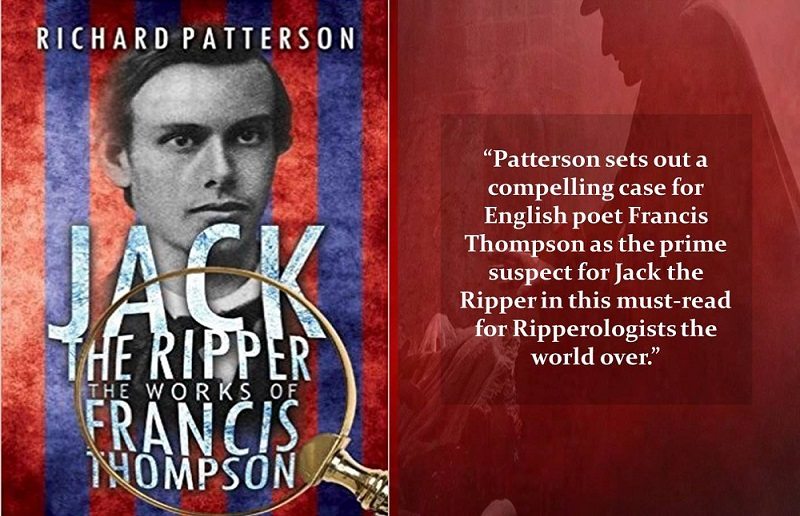For three months in the autumn of 1888, a killer roamed the streets of Whitechapel in London. Five murders have been conclusively attributed to the work of this one individual, a man who called himself Jack the Ripper. Mary Ann Nichols, Annie Chapman, Elizabeth Stride, Catherine Eddowes and Mary Jane Kelly were all murdered in the dead of night with their bodies left out on display in the most gruesome fashion. With little evidence to go on and a distinctly different form of police investigation available then to what we have now, Victorian investigators never did get close to identifying their killer.
Renowned English poet Francis Thompson is not a name anyone would expect to appear in the long list of suspects but, before you switch off, take a closer look because this suggestion taken forward today by Richard Patterson in Jack the Ripper: The Works of Francis Thompson published by Austin Macauley, has become much more than a mere thought. It has become a viable theory that is backed up by solid motives, clear opportunity and page after page of credible parallels that even the most seasoned Ripperologist cannot ignore.
While Francis Thompson has enjoyed a historical legacy as being a talented Victorian poet, he should now also be viewed as quite possibly the only viable person to have actually been the elusive Jack the Ripper.
The crimes of the serial murderer now known the world over as Jack the Ripper are more gruesome and more horrific than many people realize. The mutilation of his victims was extensive, and despite its gore and shock factor, this dissection of a body required skill and precision. For a man to carry out this kind of work in the dark on the back streets of London when he could have been discovered at any moment is, if it can be said in the same paragraph as murder, impressive. Skills which Francis Thompson had in abundance.
When American historian John Evangelist Walsh began researching Francis Thompson in the early 1960’s for his planned biography, his discoveries about the crimes of Jack the Ripper took on new meaning when he realized the parallels to the life of Francis Thompson. When he published his work on the English Victorian poet in 1967, he added a footnote referring to Thompson as a potential Jack the Ripper suspect, a note that was either unnoticed or entirely ignored.
In the winter of 1988, an article appeared in the American Society of Criminology publication The Criminologist. Written by respected American Forensic Pathologist Joseph C. Rupp, who provides the Foreword in this book, it suggested that the famous English poet Francis Thompson may have been the elusive, violent and skilled multiple murderer Jack The Ripper. This too was met with silence, so when he was contacted 27 years later by Australian author and researcher Richard Patterson, it came as quite a shock.
“If someone came to me and offered a king’s ransom to perform a partial autopsy (evisceration) in the dark, on the ground, bare handed with only a surgical knife and no assistance plus a time constraint of a few minutes, my answer would be, ‘Certainly, not, are you crazy?’” – Dr Joseph C. Rupp
Extensively researched, Richard Patterson’s book Jack The Ripper: The Works of Francis Thompson takes you through the life of Francis Thompson, but it is far from a dry account of his life. It is a fascinating insight into the early beginnings of this famous poet who by now you are starting to look at in a different light. His experiences, decisions, and actions as he was developing into the poet we know him to be, take on a different significance when looked at from the perspective of this man becoming the most feared serial killer in London.
Richard Patterson’s writing style is fluid and energetic giving detail and explanations where needed with no bulky hard going paragraphs. There are more than a few coincidences when the life of Francis Thompson and the actions of Jack the Ripper are looked at in parallel, coincidences that build into a model that places Francis Thompson in the center of the Jack the Ripper timeline. Richard Patterson is based in Melbourne, Australia and has traveled the world researching Francis Thompson and Jack the Ripper, viewing original documents and giving talks on his work.
He has spent countless hours in the Burns Library in Boston studying Thompson’s letters, visited London and the scene of each murder. His research and theory have featured in newspapers and magazines, and he has twice been a guest speaker at the annual UK Jack the Ripper Conference, in 2015 and 2016. Furthermore, his work has some key components which raise its profile; Richard Patterson can place Francis Thompson at the scene of all the murders, and he can provide evidence for motive and opportunity.
“When the murders happened Thompson, then an ex-medical student, lived just a 15 minute walk to where all five women were knifed. The bed of this man, whose writing shows a hatred of prostitutes, was only 100 meters, just up the street, from the last victim. At this time Thompson was carrying, under a long coat, a knife, which he kept razor sharp, while he was hunting for a prostitute after their failed relationship.” – Richard Patterson
Francis Thompson is known to have had a difficult life. Despite a promising career ahead of him as a doctor his failure at medical school did not place him well in the eyes of his family. However, six years of medical training and hour upon hour dissecting cadavers provided Francis Thompson with some unique abilities when it came to the dissection of the human body. Desertion of his studies and travel to London in 1885 saw the start of his homeless status, drifting from lodgings to lodgings using opium as a way to relieve his failings.
Thomas De Quincey was an English writer whose name was often spoken in the same breath at Edgar Allen Poe and was somebody Thompson identified with. The dark writings of De Quincey were picked up on by the press around the time of the Ripper murders as a comparison, fiction that could be presented to the public who had never seen anything as grim and gruesome as the Jack the Ripper murders in real life.
“Have we a murderous maniac loose in East London? It looks as if we have. Nothing so appalling, so devilish, so inhuman…” – The Star newspaper
Following in the footsteps of De Quency, Thompson found his way to London and a life on the streets. Thompson himself quoted De Quincey’s work, and there were many similarities in their lives.
The travels to London, the homelessness, the struggles to become a writer, the addictions they both had to opium. Did Thompson internalize these dark words from literature and in his twisted drug-fuelled mind bring them to life and give them meaning?
This chapter of Thompson’s life, the time before he ‘made it’ as a literary marvel and successful poet is one most are unfamiliar with, but it is a period vital to the theory of Thompson being Jack the Ripper. In 1885 Thompson is in London going from lodging to lodging until he stopped accepting payouts from his father. He was now truly homeless in clothes that had been worn down to rags.
When Francis Thompson became ill with fever, he was prescribed laudanum, a drug based on opium and it was this which would kickstart Thompson’s lifelong drug addiction. He was hired by a shoemaker John McMaster in August 1886 who took pity on him, describing him as a “dilapidated opium-haunted wreck”. Money to Thompson meant more opportunity to get hold of more drugs which he continued to favor over food, clothing or lodgings.
Despite his poor status, Thompson was determined to succeed and he pushed himself to write. The significance of a poem he wrote during this period is striking. The Nightmare of the Witch Babies was most likely written while Thompson was under the influence of his beloved laudanum, but it is a dark and gruesome piece of writing that promotes concern for the mind of the person behind the pen.
His experiences up until that point have combined into words and to an outpouring of his emotional state. It is a poem of revealing insight into the actual reality of the mind of Francis Thompson. “It shows his rage against women who abandon and betray him. The poem begins with the protagonist, a ‘lusty knight’ on a hunt, but he hunts in London, after dark, and his game is women.” says Richard Patterson.
The descriptions in this poem, the detail, and the violence is unmistakable. “..soon he begins to stalk her, swiftly he followed her. Ha! Ha! Eagerly he followed her” he writes. “…the knight captures her and decides to kill her. He slices her open and drags out the contents of her stomach, he guts her like an animal..” he continues.
This poem is a blueprint for brutal, violent and gruesome murder detailing the slaughter of a woman who is gutted with a focus on blood and death. It is dark, it is disturbed, and it is terrifying. “To him, his poems were records of real events in his life clothed in rhyme and symbolism”, says Richard Patterson, pointing out that Francis Thompson told his editor in his own words “the poems were, in fact, a kind of poetic diary;…”.
Francis Thompson is telling the truths of his life through his poem. He is using his writing and his poetry, at his own admission, as a personal recording of his own life and potentially his own actions. In June 1887 a woman appeared in his life. She was a prostitute, the type of woman that Thompson despised and had written in so much detail about killing so very brutally in his Witch Babies poem, yet here he was entering into a relationship with one such woman. Still today the name of this woman has never been discovered, but she existed, only to leave him just as his writing got picked up by editor and journalist Wilfrid Meynell, the man who would mold his legacy as a respected poet, particularly after his death.
Addressing all the myths and debated issues surrounding the Jack the Ripper murders including the infamous ‘Dear Boss’ letter, and the notion that Francis Thompson was too intoxicated by his drug addiction to have carried out the murders, Richard Patterson illustrates his argument with quotes and narrative from official documents of the time, from those who knew Francis Thompson and through Thompson’s own words in his poems. With a concluding chapter which brings all the strands of Francis Thompson’s life, his works, and his skills together in line with the activities of Jack the Ripper, this book is an impressive piece of work which delivers on its promises and opens the narrative for Francis Thompson being Jack the Ripper with an undeniable impact.
Also included is the full article “Was Francis Thompson Jack the Ripper?” published by Dr Joseph C. Rupp in 1988 and Thompson’s Finis Coronat Opus: The Final Crowning work giving an insightful look at his thoughts and state of mind in 1889, one year after the Ripper murders took place.
Jack the Ripper: The Works of Francis Thompson is an extensive piece of work in a book which highlights a perceived mild-mannered famous poet, as a man with a dark past. A past which may have included serial murder. If you have an interest in the legend that is the Ripper and the theories which surround him and his horrific crimes, this book does indeed deliver a compelling argument for Francis Thompson as the killer that just may well have solved the Jack the Ripper murders.
‘Jack the Ripper: The Works of Francis Thompson‘ by Richard Patterson is available at Amazon.
Unlimited reading on any device, try Kindle Unlimited from Amazon for free
Prefer Audiobooks? Audible 30-Day Free Trial with free audiobooks




The ONLY damning evidence I have seen that Thompson MIGHT have been “the Ripper” is the first two verses in his weird poem “The Nightmare of the Witch Babies” in which he refers to “the Land of the Bare Shank-Bone”. The photograph of Mary Kelly shows her with her right leg flayed to the thigh-bone; referred to by Jews as the “SHANKBONE”, though it is a term of VETERINARY medical science designating the rear leg bone of FOUR-legged animals such as horses and COWS! Coincidentally, the Hebrew word used of NON-Jews BY JEWS, “GoYiM”, means “CATTLE”!!
I have also read a CONTRADICTORY excerpt from Patterson’s book about Thompson’s statements allegedly alluding to HIMSELF as “the Ripper” or a “killer of prostitutes” were either BURNED or EDITED by his editor. So then WHERE did Patterson get the alleged “testimony” from Thompson incriminating himself?? It doesn’t make sense. One would THINK Thompson’s editor who was also his LITERARY AGENT and HEIR to his publication profits would make CERTAIN he COMPLETELY CENSORED any such references!!